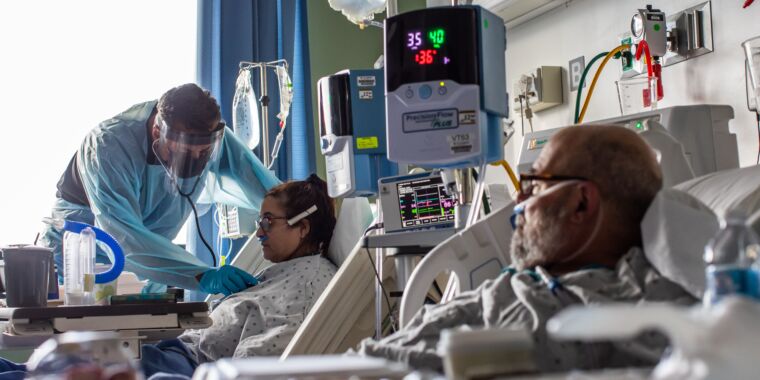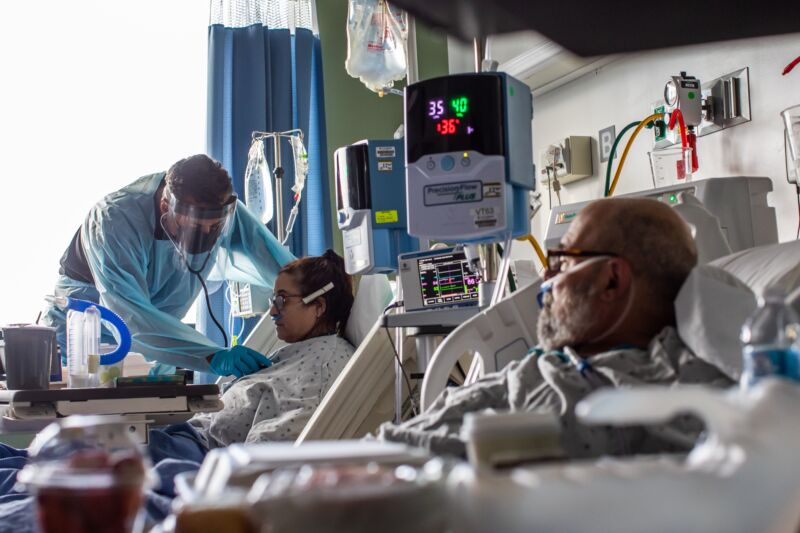

The ultra-transmissible omicron coronaviruses variant is sending a record number of people to emergency departments and hospital rooms in the US, swamping health care systems nationwide.
The highest seven-day average of daily cases was nearly 789,000, a 386 percent increase from the highest average of daily cases seen during the delta wave. The highest daily average of emergency department visits was 86 percent higher for omicron than for delta.
The data comes from a study published on Tuesday by the Centers for Disease Control and Prevention. Even though the omicron wave has been marked by relatively smaller proportions of severe cases and deaths, it has still overwhelmed hospitals and taken a devastating toll on the nation.
Although patients hospitalized during the Omicron period have shorter stays and less frequent ICU admissions, the high volume of hospitalizations resulting from high transmission rates during a short period can strain local health care systems in the United States.
The highest average of daily deaths during the omicron wave was 1,854, a decrease of 4 percent from the high seen during the delta wave. The peak during the delta wave was over 2,300 per day.
"Milder" does not mean "mild", and we cannot look past the strain on our health systems and large number of deaths," CDC Director Rochelle Walensky said Wednesday during a White House COVID-19 press briefing.
At this point, cases and hospitalizations are declining on a national level. The US has seen an average of 652,000 new COVID-19 cases per day, down from an all-time high of over 800,000 on January 14. The average number of people hospitalized with COVID-19 has fallen from an all-time high a week ago.
People with omicron tend to fare better in the hospital than those with delta. The percentage of hospitalized patients requiring mechanical ventilation during the omicron wave was lower than during the delta wave, according to a study by the CDC. The percentage of hospitalized patients dying was smaller. The length of hospital stays was shorter with a mean during the omicron wave of 5.5 days.
The proportion of severely ill people is lower. The ratio of emergency room visits to cases peaked at 87 visits per 1,000 cases, compared with 167 visits per 1,000 cases for Delta, according to the CDC study. The hospitalization rate was 27 admissions per 1,000 cases. The deaths from omicron had a ratio of nine deaths per 1,000 cases, down from 13 deaths.
It's cold comfort for people who end up in the hospital and for the exhausted medical staff caring for them. According to the CDC study, as much as 20.6 percent of staffed hospital beds were taken up by COVID-19 patients during the omicron wave, which is 7.2 percentage points higher than the peak seen during delta. The Department of Health and Human Services reported that 21 percent of hospital beds were taken up by patients with COVID-19.
Hospitals are already short-staffed from previous waves, and providers themselves are struck down by omicron. The health officials in Idaho instituted crisis standards of care due to staff shortages.
Idaho Department of Health and Welfare Director Dave Jeppesen said in a statement that the highly contagious omicron variant has thrown them a curve ball.
A sixth hospital in Michigan will get help from federal medical staff to combat the latest COVID-19 surge. The Ohio National Guard arrived at the University of Cincinnati Medical Center.
UC Health is experiencing a record number of patients seeking care in our hospitals, and this is putting unprecedented strain on our care teams. The Enquirer said that hospital workers described the recent pressure as a "PTSD-like situation" after two years of Pandemic-related exertion.
In the White House briefing, Dr. Walensky urged Americans to do what they can to limit transmission, including wearing masks and getting vaccinations.